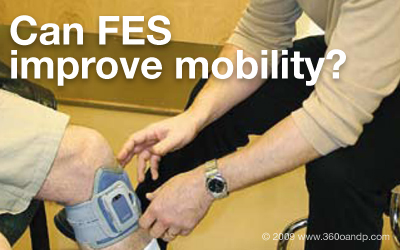
Almost two-thirds of all people living with MS report that trouble walking takes the biggest toll on their quality of life1 and one of the leading causes of difficulty walking is foot drop, a weakness or paralysis of the muscles that lift the front of the foot. People with foot drop often drag their foot and hike their hip to take a step, causing long-term damage to muscles and even bones and making walking miserable.
A recent advance in the field of neurostimulation is offering a new approach. Functional electrical stimulation or FES technology uses low levels of electrical current to stimulate nerves in the extremi- ties. My patients often say that FES therapies create a light tingling sensation as electrical impulses activate specific muscles. FES is not a cure for the damage caused by
see you for only a few minutes in a setting that doesn’t reflect your typical daily activities. For some people, foot drop is only present after sustained exertion. Let your provider know about all the dif- ficulties you experience when walking.
The foot drop diagnosis
Before investigating a FES device, it is critical to obtain an accurate diagnosis. Walking problems may be caused by other conditions.
In order to determine if foot drop is present, make sure your health-care team is aware of all the mobility challenges you face. A busy physician may see you for only a few minutes in a setting that doesn’t reflect your typical daily activities. For some people, foot drop is only present after sustained exertion. Let your provider know about all the dif- ficulties you experience when walking.
Therapeutic options
In the past, the treatment for foot drop was a rigid plastic ankle-foot orthosis (AFO) worn around the leg. Many different varieties of AFO are available and they are effective, but patients using them may experience discomfort, trouble getting the brace into a shoe, and even muscle atrophy as the AFO limits motion.
A new alternative is an FES device, which can be used independently after the patient has worked with a physical therapist. At present there are two devices on the market. Both are FDA approved, and both stimulate the peroneal nerve which, in turn, signals under-active muscles in the leg to raise the foot at the appropriate time during the step cycle.
NESS L300
The NESS L300TM Foot Drop System is worn in two parts—a small transmitter in the shoe and a device fitted below the knee. For more info: bioness.com.
WalkAide
The WalkAide consists of a battery-operated, single- channel electrical stimulator, two electrodes and electrode leads. For more info: walkaide.com.
A case in point
James has the typical mobility challenges that I frequently see in my MS patients at Shepherd. His work requires business trips with a lot of walking, especially at airports. At the end of his working day, James would drag the toes on his right foot and often fell. He was prescribed an ankle-foot orthosis, but rarely used it because he said it was uncomfortable.
At Shepherd, James was given an FES device for the foot drop on his right side. James reported that he did not fatigue as easily, was moving faster and had not fallen since using the device.
Insurance coverage
To date, neither the WalkAide nor the NESS L300 is covered by Medicare except under certain diag- nostic codes for incomplete spinal cord injury. Some private insurance does cover the devices on a case-by-case basis. I advise my patients to ask their FES device manufacturer for information about trial rental programs and third-party financing options.
Ideally, FES therapy should begin during out-patient rehabilitation and be covered by insurance. Patients should use FES devices during six to eight follow-up therapy visits in order to learn how to properly operate and maintain the device. Therapy should be followed by a home trial period and ulti- mately purchased if benefits are experienced.
When FES does not work
FES offers great potential for lessening the effects of foot drop, but it will not be the answer for every- one. Working with a physical therapist, each person can determine the best individual plan of action for improving mobility. That plan might include an AFO or FES device, strengthening and stretch- ing exercises, or using equipment like a cane or a walker. Even if FES is not a good option in your situation, there are other ways
to help you keep moving while living with MS.
Ben Thrower, MD, is the medical director of the Andrew C. Carlos MS Institute at Shepherd Center, Atlanta, Ga.
Momentum • Summer.2010